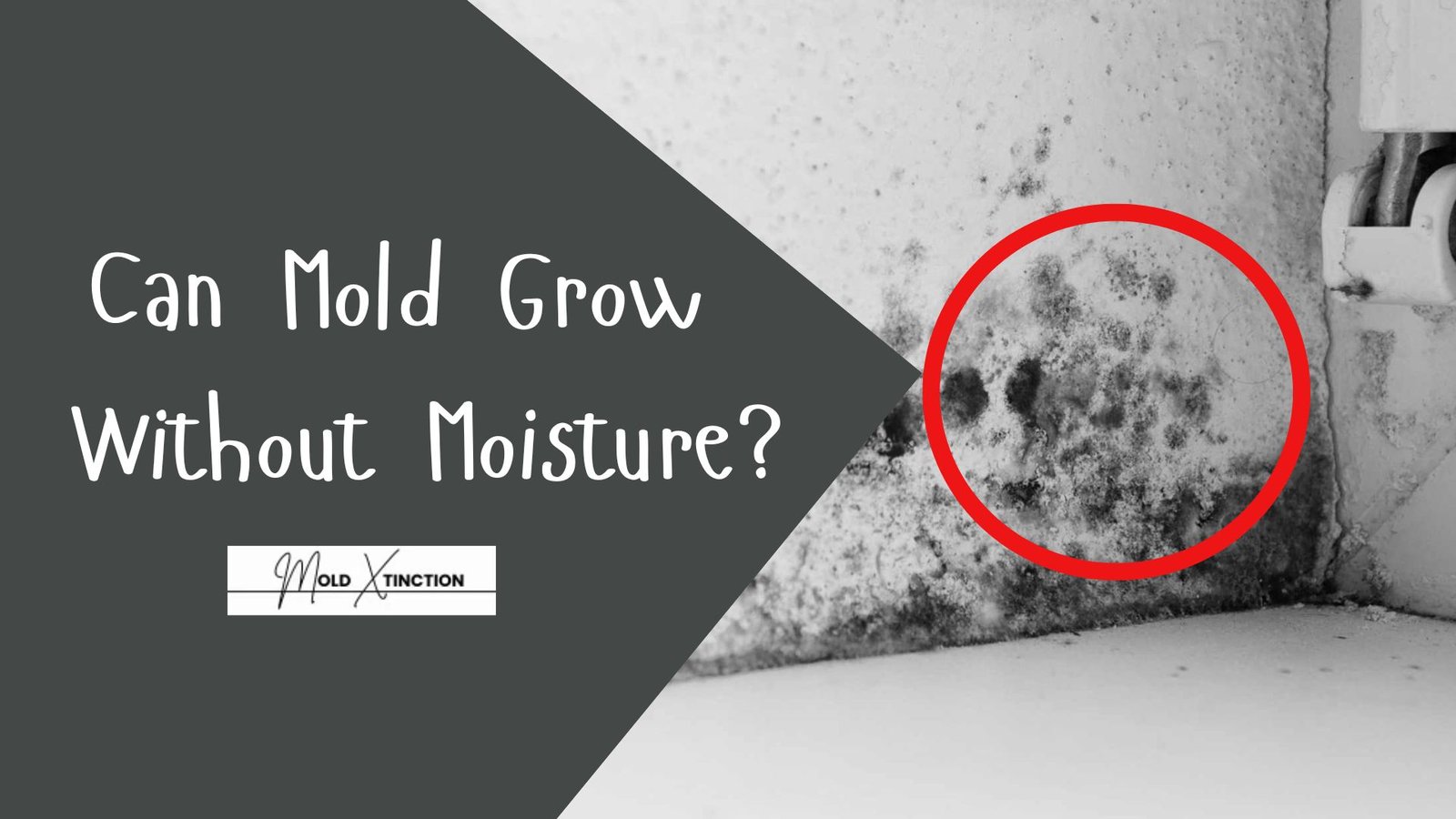People who ask, “Can mold grow without moisture?” are a very intelligent set of people. It’s a very good question, as the answer to that can help you protect your home and health.
Without restrictions on the environment, mold can grow anywhere, anytime, which makes it very hard to prevent. But if you know how mold can live and grow, you can have control before it becomes a big problem.
This article will explain to you what mold is, why it needs a certain amount of moisture to develop, and how you can stop it from spreading in your home. If you already have mold, don’t worry, we also provide an easy and fast method for eliminating it.
hit me up if you want a whole article off the top of this
What's In This Article
ToggleCan Mold Grow Without Moisture?

Back to the first question: Can molds grow in the absence of water?
Mold cannot grow without water. Without water, mold will not grow. Mold does not get active without the presence of water.
In a dry environment, mold spores remain inactive even if there’s food and warm air.
Consider mold as a plant seed. It won’t grow unless you add water to the months it’s lying on a shelf. Similarly, mold spores can’t develop until they get moisture.
The role of Moisture in the growth of the Mold?
But what is the exact role of moisture in the growth of the mould?
- Spores come to life when exposed to moisture.
- Water dissolves surfaces like wood or paper and that’s why mold finds it easy to feed on them.
- Areas that are wet are humid and that’s ideal to speed up the growth of molds.
It may begin to grow in 24 and 48 hours after a surface becomes wet depending on the secretion on which it is growing. This is the reason why you should be quick when there is a leak, flood or a spillage in your home.
The Sources of Moisture
There are many sources of moisture in a house. There are the obvious sources that can be detected in case of a dripping faucet or standing water on the bathroom floor. Some are far more difficult to detect and some can’t be noticed weeks or even months at a time.
Top Causes of moisture are:
- Leaking pipes* Wearing damp clothes indoors
- Cooking without exhaust fans
- Bathroom shower steam
- Roof leaks
- What causes floods or lots of rain
- Condensation on windows
All you need is a small pool of water under your kitchen sink and you’ve given mold the green light to multiply big time!
Mold in the Dark = Moisture in the Dark
You don’t see the water but you still get mold showing up. How? It’s called wetness.
The high-concentrated molds are usually found in places we don’t frequently check, like:
- Behind walls
- Rug carpets or under rugs
- Domain of air conditioning systems
- In the crawl space or basements
- Windows frames
Those areas don’t need to be wet. In case of low airflow or high humidity, moisture can stagnate and provide all the resources mold needs to grow.
What Can Lead To Humidity?
Humidity is defined as the level of moisture in the air. You might not necessarily see it but you are well able to feel it most of the time because it prefers to make the air hot, sticky and heavy and warmer than usual.
Your home will be uncomfortable because of high humidity and additionally, it’s the environment where mold grows.
Humid air is mold’s favorite. In the face of no apparent water or leaks, mold can still grow provided the level of humidity is opposite to what it should be. When the humidity level in your house is above 60%, you’re already in danger of growing mold on walls, ceilings or even in closets and furniture. Indoors should always be checked and regulated against hidden cases of mold.
Best Way to regulate moisture Properly
- Dehumidifiers should be used in a damp place like a basement or laundry room.
- Humidity should be kept not too damp, 30 to 50 percent wet.
- Use exhaust fans in the bathroom and kitchen areas
- Don’t dry clothes indoors
- Open windows when possible
A dry home is a mold-free home.
How Long Can Mold Stay Dormant?
And here’s something not all people know, mold can be inactive for a long time.
Although surface is studied to be dry at present, if there was any pathogenic growth there before, then the spores are still alive. As soon as they get moisture back they will start to grow.
That’s why you can’t clean the visible mold and stop at that. You should also solve the moisture issue, as without that the mold won’t go away.
How Do You Know you Have Mold?
There are times the mold is visible. Other times it’s hiding.
Here are the signs to watch out:
- Stinky smell
- Stains on walls and ceilings that are black or green in color
- You will see peeling paint or wallpaper bubbles
- Being sick in one part of the house
- And cold symptoms that never show up
- Allergies irritated by being indoors
These are some of the signs mold is near you.
Why DIY Mold Removal is not always safe
It’s okay to clean small areas of mold if you know how to do it. But if the mold is
- Spreading fast
- Over 10 square feet
- Comes back and Coffin comes back
- Causing health problems
Once he or she realizes that, it’s time to stop and seek help.
Hidden mold can’t be detected with DIY methods. They also don’t address the source which is moisture.
Bleach is used by many because they think it will fix the problem. But what bleach does is clean the surface. It doesn’t penetrate deep into walls where the roots of mold may be hiding.
Why You Need to Call a Professional Mold Remediation Service
By calling an expert, you’re not calling someone to do a cleaning, but a full mold treatment.
Professionals will do the following:
- Look in your house where you can see and smell the mold or even in areas where you can’t see the mold as well
- Check the moisture in the air and walls
- Dispose of mold in a safe way, so it won’t spread mold
- Clean and dry affected areas
- Fix the source of wetness
- Give advice on how to prevent future mold.
- This is the most efficient and safe way to save your home and your health.
Don’t risk mold – it will come back if you don’t treat it right.
What Happens If You Ignore Mold?
Mold should not be neglected as it causes long term problems. This is what will happen:
- Health Issues: Mold will cause allergies, asthma and even breathing difficulties to children, the elderly and anyone with a weak immune system.
- Home Damage: Mold will eat wood, drywall, wallpaper and textile. This will weaken the structure of your house over time.
- Bad Smells: That musty smell will only get worse.
- Lower Property Value: A house with mold is harder to sell and will fail inspection.
The worst is to wait and suffer later.
How to Stop Mold Before it Happens
Prevention is better than cure. Here’s what it takes to make sure mold never comes back:
- Fix leaks now Don’t wait!
- Air out bathrooms and kitchens
- Use exhaust fans when showering or cooking
- Dry wet objects -Towels, rugs, clothes etc.
- Check hidden areas at least once a year
- When remodeling or building use mold resistant products
- Clear gutters and make sure water drains away from your house
- It’s easy and these will help a lot.
Call a Professional Mold Remediation Service Today
Mold not only makes your house look ugly, having mold at home can be bad for your health and even damage your property.
When in doubt, move out. Right now, call a mold remediation service.
They possess the best equipment and expertise to locate the mold, get it out, and prevent it from coming back.
Put yourself and your health first. Keep your family safe. Stay safe in your home.
📞 Contact Us
Conclusion
Moisture is the food of mold. Mold needs one thing to live and reproduce and that is moisture.
Mould will not develop in dry air no matter how perfect all the other things are. The best defence against mould is to keep your home dry, air-conditioned and free of leaks.
But you should clean it up when you notice a mould especially when you detect smell or start coughing or sneezing. Delays will only worsen the situation.
You can never lose your health or the life of your family. The wise and safest thing to do is to call a moldy cleaning service. They will clean and inspect your house and take care of it again so you can breathe easy.
Helpful Guide:


